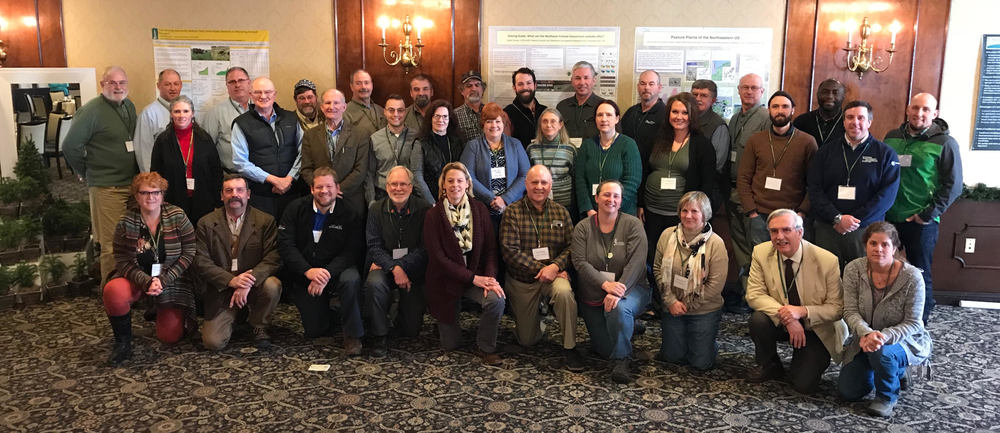The 2018 annual conference was held in Latham, NY at the Century House Hotel and Conference Center on January 25 and 26.

The meeting materials include the speaker list and poster abstracts, and the full meeting report may be downloaded as a single large pdf.
Session 1 - Riparian Area Management in Pastures¶
Our first technical session on January 25 was on Riparian Area Management in Pastures. This topic has been a focus of our Consortium for several years as we prefer to see a more holistic approach to managing pastures in riparian areas, rather than merely fencing off the streams running through them to exclude livestock entry to the water and streambanks. Most often pasture grazing management outside the exclusion area is still wanting and is grazed much too intensely. This leads to contaminated runoff leaving the pasture, more than likely entering the stream unfiltered. ARS and Penn State University have been working on a Riparian Conservation Planning Project for four years. This session was held to up-date our stakeholders on their progress on evaluating riparian areas on pasturelands and coming up with conservation options that reduce the impact of grazing on riparian areas and stream water qual-ity. Two co-workers from the Project Team presented their findings.
Session 2 – Private Sector and Public Sector Breakout Sessions¶
The rest of the morning was devoted to two concurrent sessions, a Private Sector Breakout Session moderated by Angus Johnson, that discussed the renewal the Stakeholder Action Committee and a Public Sector Breakout Session led by Jennifer Colby that discussed Riparian Area Grazing Management implementation strategies.
Session 3 – Pastures and Soil Health¶
Pastures and Soil Health was the first afternoon session. Soil health is a more recent addition to our research and education priorities.
Session 4 - Silvopasture Update¶
This session was given by Brett Chedzoy, SCNY Ag Team-Forestry Specialist & Senior Resource Educator, Montour Falls, NY. His presentation title was: Silvopasturing Updates on Progress in the Northeast. Brett defined silvopasturing as the long-term integrated production of quality timber and grazing on the same land. It can be done two ways, adding woods to pasture, or adding pasture to woods. Many popular press and research articles have been written to promote silvopasturing, such as in Farm magazine that serves PA, NY, and New England, On Pasture e-newsletter, Graze magazine, Journal of Forestry, and a publication, Photo Guide to Northeastern United States Silvopasture, by the Northeastern States Research Cooperative through funding from the USDA Forest Service.
Poster Paper Session¶
Six poster papers were displayed.
Session 5 – Beef Viability Case Studies¶
Beef Viability Case Studies followed the Poster Paper Session with Sam Smith, Farm Business Specialist, Intervale Center, Burlington, VT presenting Beef Viability Case Studies via Skype. Several grass-fed beef farms have sprung up in Vermont. Case studies were conducted to see what production models these farms were using.
The report accompanying the presentation given by Allen Matthews, Director and Instructor of Sustainable Agriculture, Chatham University, Pittsburgh, PA, on Grass Fed Beef Value Chain Marketing is available here.
Session 6 - Soil Health and its Impact on Human Health¶
Soil Health and its Impact on Human Health was the last Thursday afternoon session with Didi Pershouse, Director, The Center for Sustainable Medicine & Board Member, Soil Carbon Coalition, Thetford Center, VT presenting The Ecology of Care.
Producer Showcase Session¶
The Thursday evening Producer Showcase ran from 7:00 PM to 9:00 PM. Two New York dairymen were featured, Bruce Rivington and Eric Sheffer.
Session 7 – The Saturated versus Unsaturated Dietary Fat Controversy as it relates to Pasture-raised Dairy and Meat Products¶
On Friday, January 26, the last technical session was presented at 8:00 AM, Session 7 – The Saturated versus Unsaturated Dietary Fat Controversy as it relates to Pasture-raised Dairy and Meat Products. Our 2017 Conference concentrated on how pasture fed milk and meat products differed in fatty acid composition from confinement fed milk and meat products and how those fatty acids might be affected by processing and cooking. We also learned from nutritionists and dieticians that these fatty acids in pasture fed products tended to be the ones considered to be more heart healthy or more favorable to human health generally. After our Conference in March another conference was held in June that had experts speak out that people have been misled about saturated fats clogging our arteries. We invited two of those speakers at this year’s NEPC Conference. What if we feed our livestock to change fatty acid composition in meat and milk and find out that the old nutritional science has it all wrong?
Concurrent Sessions on Prioritizing Pasture Research, Education, and Technical Assistance¶
With the end of the technical sessions, the private sector and the public sector met in separate rooms to formulate changes to our pasture research, education, and technical assistance priorities. These two breakout sessions were chaired by Cliff Hawbaker, Private Sector Co-Chair Elect and Jessica William-son, Public Sector Co-Chair Elect of the Executive Committee. We were all amazed at how similar both sectors were in the priorities they named and how to proceed with them when Cliff and Jessica reported back at the afternoon Reports session.
The meeting concluded with a series of reports, followed by the business meeting.